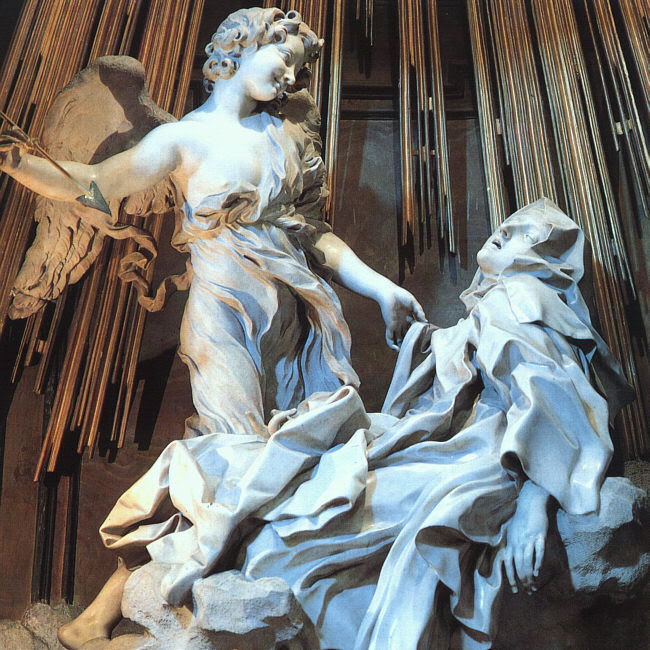MYSTICISM

The direct, unmediated experience of the Divine
The orthodox adhere to the accepted or traditional and established faith. They cleve most closely to the practices approved by the institution.
The mystics pursue communion with, identity with, or conscious awareness of an ultimate Reality, Divinity, Spiritual Truth, or God through direct experience, intuition, or insight. Their practices nurture that experience or awareness.
Common Elements of the Mystical Experience
No matter the context, no matter the reason for its occurrence, there are some common elements that occur in most mystical experiences. The number of them depends on the study, but these seem to be the most common:
It is ineffable (apophatic) The mystic is unable to capture or explain the experience in ordinary language (this leads to the use of analogies like the garden or the fountain).
It is noetic It is an intuitive apprehension (insight, awareness, revelation, and/or illumination) beyond the grasp of the intellect. You can't know it, but it is real nevertheless.
It is passive It happens to someone; it's beyond human control. The mystic isn't an actor, but is acted upon.
It unites opposites There is a sense of completion, of unity, either with the Divine, all of humanity, or all existence.
It is timeless Within the experience, the mystic loses all sense of time.
It reveals "the true self” It presents a sense of the self exiting beyond life and death, beyond difference and duality, and beyond ego and selfishness.
The Mystical Experience isn't a process. It's not a way of life or a meditation technique. You can't force a mystical experience. Most religious mystics characterize their experience as a gift, something that they did not earn but was given to them. The best you can do is to make yourself available to receive that gift. The term for that is disponibility.
MYSTICISM IN ISLAM - SUFI
Dervish literally means "doorway" and is thought to be an entrance from this material world to the spiritual, heavenly world. In the past the Turkish Sultans would often consult the Dervishes for guidance. They believed that the dervish was in prayer and that the spinning created a hypnotic and relaxing affect which opened his body to receive the energy of God.
The sema is the inspiration of Mevlana Celaleddin-i Rumi (1207- 1273) as well as of Turkish custom, history, beliefs and culture. It is part of a sacred ceremony in which the dervish rotates in a precise rhythm. While whirling, the dervish aims to empty himself of all distracting thoughts. As he enters into a trance, he is released from his bodily awareness and conquers his dizziness. Dervishes believe that their souls are released from earthly ties, able to freely and jubilantly communicate with the divine. The Sema has seven parts, of which the whirling is the fifth.
"While whirling his arms are open, his right hand directed to the skies ready to receive God's beneficence, looking to his left hand turned toward the earth, he turn from right to left around the heart. This is his way of conveying God's spiritual gift to the people upon whom he looks with the eyes of God. Revolving around the heart, from right to left, he embraces all the mankind, all the creation with affection and love."
Dervishes dancing, working toward a mystical trance

MYSTICISM IN HINDUISM - VEDANTA
Consciousness is Brahman.
The aim of human life is to realize that Consciousness is Brahman.
Vedanta represents the philosophical portion of the ancient scriptures of India, the Vedas. Specifically, it refers to the final portion of the Vedic literature, the Upanishads, but it also includes the Bhagavad Gita, the great epics of India, as well as the Puranas, along with many other texts, hymns, and writings. The basic teaching concerns the ultimate identity of the individual soul with the Supreme Soul.
The goal of Vedanta is for the seeker to have the direct experience of his or her true nature, and it is held that each and every one of us is qualified to have that highest illumination, if we are willing to put forth sincere and intense effort.
In other words, the goal of Vedanta is a state of self-realization or cosmic consciousness. Historically and currently, it is assumed that this state can be experienced by anyone, but it cannot be adequately conveyed in language. Since it is direct and unmediated by the senses, it is ineffable.
MYSTICISM IN CHRISTIANITY - THE VIA NEGATIVA

This opening verse from the "Song of Songs," with its enigmatic address (who is speaking to whom?) and erotic imagery of kisses and breasts, was one of the central scriptural foundations in the history of Christian mysticism.
It was only in the post-Enlightenment period that the Song became in some way suspect — a kind of embarrassment to "decent" Christians. For fifteen and more centuries, pious Jews and Christians viewed it as a central, we might even say the central, text of God's revelation to his people. Origen was typical in seeing it as the greatest of the Bible's songs, the one that expresses the highest form of its whole inner teaching. Indeed, if Christianity had not had the Song of Songs, it might well have had to create one, in a way analogous to how Sufi mystics utilized pre-Islamic love poetry (Qasida) in order to express their pursuit of the Divine Lover.
Various denominations of Christianity have developed certain practices in order to make oneself disponible to direct communion with the Divine. The Eastern Orthodox Churches have the tradition of the Hesychia, or Jesus Prayer. Julian of Norwich speaks of the three ways in which mystics directly experience the Divine:
First, bodily visions, meaning to be aware with one's senses—sight, sound, or others; second, ghostly visions, such as spiritual visions and sayings directly imparted to the soul; and lastly, intellectual enlightenment, where her mind came into a new understanding of God.
not to the easiest thing, but to the hardest; not to the tastiest, but to the most insipid; not to the things that give the greatest pleasure, but to those that give the least; not to the restful things, but to the painful ones; not to consolation, but to desolation; not to more, but to less; not to the highest and dearest, but to the lowest and most despised; not to the desire for something, but to having no desires.
Since the experience is ineffable, mystics speak about their communion through analogy. The most common analogies throughout the centuries have been sexual in nature. That is, communion with the Divine is like communion with another person through sex, only better.
Take a look at the details from Bernini's statue below, if you're having problems understanding this analogy.


I saw in his hand a long spear of gold, and at the iron's point there seemed to be a little fire. He appeared to me to be thrusting it at times into my heart, and to pierce my very entrails; when he drew it out, he seemed to draw them out also, and to leave me all on fire with a great love of God. The pain was so great, that it made me moan; and yet so surpassing was the sweetness of this excessive pain, that I could not wish to be rid of it.
from The Life of St. Teresa of Jesus, of the Order of Our Lady of Carmel. Written by Herself. David Lewis, translator, 3rd ed., enlarged, Benziger, 1904.
Father Gabriel of St. Mary Magdalen, OCD. Divine Intimacy. Rome: 1952
Julian of Norwich. Revelations of Love. Translated by John Skinner, Bantam Doubleday Dell, 1996.
McGinn, Bernard. "Mysticism and Sexuality." The Way Supplement vol. 77 (1993), pp. 46-54.
"What is Vedanta?" Vedanta Center of Greater Washington, DC. 2 December 2012.